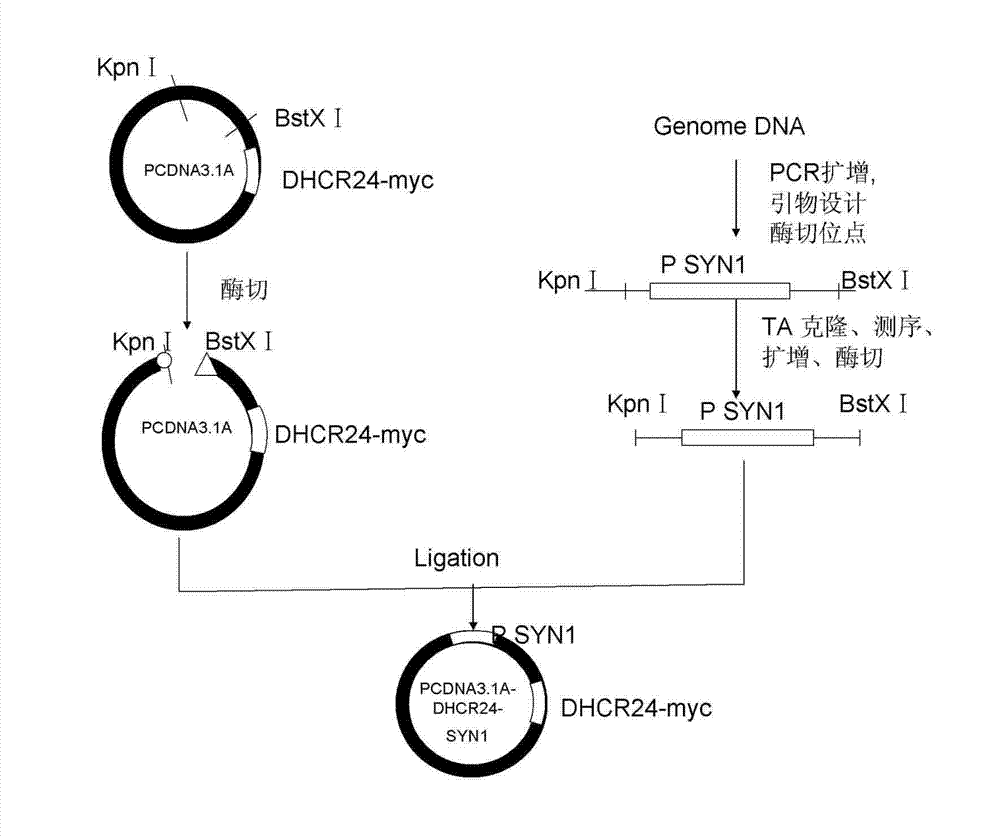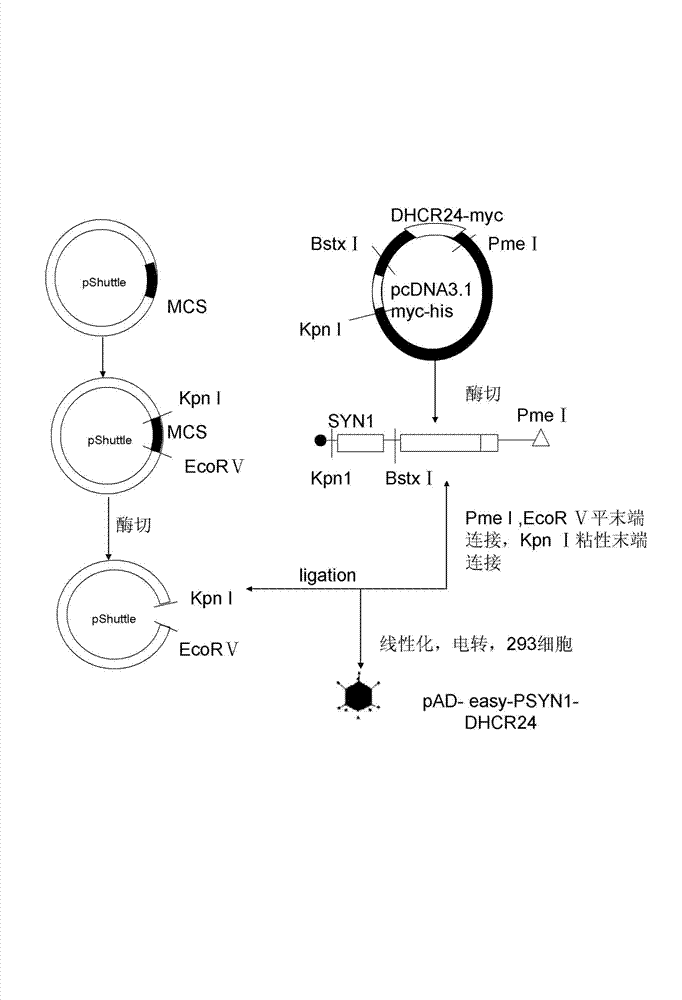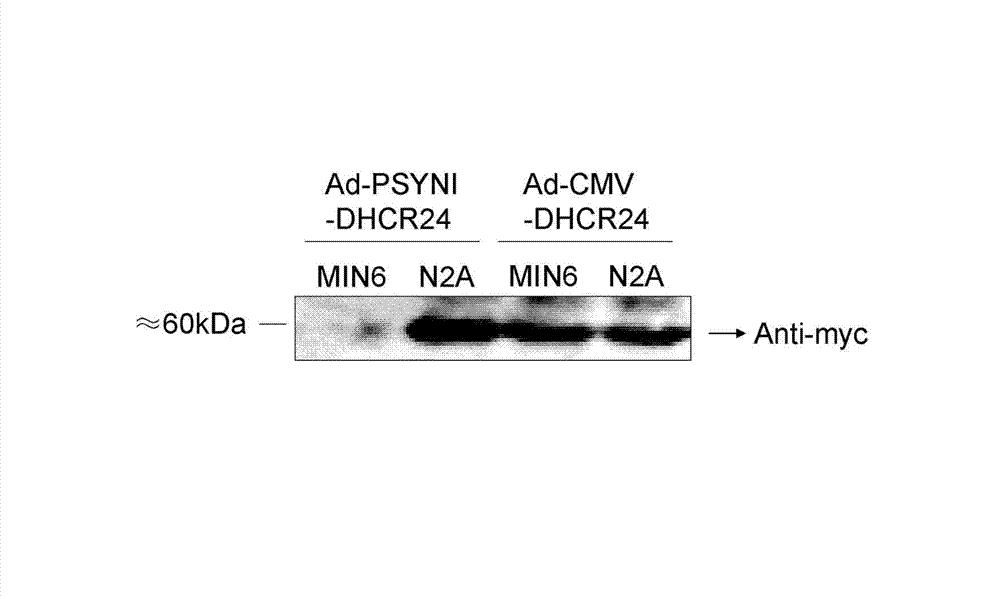24-dehydrocholesterol reductase coded recombinant adenoviruses specifically expressed in tissue
A technology of dehydrocholesterol and recombinant adenovirus, applied in virus/phage, biochemical equipment and method, application, etc., can solve problems such as difficulty
- Summary
- Abstract
- Description
- Claims
- Application Information
AI Technical Summary
Problems solved by technology
Method used
Image
Examples
Embodiment 1
[0048] Example 1: Construction of a defective adenovirus expressing the coding gene of DHCR24 (see Genbank).
[0049] This example describes the construction of a defective recombinant adenoviral vector carrying the gene encoding DHCR24, which is linked to the SYN promoter by genetic engineering techniques.
[0050] Firstly, HEK293 genome DNA (ATCC CRL-1573) was used as a template, Kpn I and BstX I restriction sites were added to the upstream and downstream primers, and the promoter sequence of SYN1 with a length of 500 bp was obtained by two-step nested PCR amplification ( P SYN1).
[0051] hSYN1-Ex S: 5-gcctgtgtggatgtgggagactaat-3
[0052] hSYN1-Ex AS: 5-tgcaggtctgtcatgtacccatttg-3
[0053] hSYN1-In S-KpnI: 5-ggtacctgacgaccgaccccg-3
[0054] hSYN1-In AS-BstXI: 5ccagtgtggtggggctgcgacttgggg-3
[0055] The obtained PCR amplification product of PSYN1 was cloned and sequenced by TA, the obtained positive clone was amplified by Escherichia coli, and the DNA was extracted ...
Embodiment 2
[0061] Example 2: Expression of DHCR24 gene in neural cells and other cell lines infected by Ad-DHCR24 vector in vitro.
[0062] The expression of DHCR24 after infection with Ad-PSYN1-hDHCR24 vector was tested on different cell lines: neuroblastoma cell line (N2A) and islet β-cell line (MIN6).
[0063] After infecting the cells with Ad-PSYN1-DHCR24 vector at 20 moi (multiplicity of infection) for 48 hours, the cells were collected and the total cell protein was extracted. Ad-CMV-DHCR24 was used as a control (recombinant adenovirus driven by CMV ubiquitous expression promoter to express DHCR24, for details, see the literature published by Lu et al. in Endocrinology, 149: 3267, 2008). Then Western Blotting was used to detect the expression of DHCR24 protein. The antibody uses anti-myc antibody (myc is the C-terminal tag sequence of DHCR24 protein). The result is as image 3 As shown, in the Ad-CMV-DHCR24 transfection group, both N2A nerve cells and MIN6 islet β cells were o...
Embodiment 3
[0064] Example 3: Study on the protective effect of Ad-PSYN1-DHCR24 on nerve cells.
[0065] The Ad-PSYN1-DHCR24 vector was used to infect N2A nerve cells at 20 moi, and the recombinant adenovirus Ad-CMV-LacZ (LacZ, β-galactosidase, a bacterial protein) was used as a control. 48 hours after adenovirus infection, the cells were treated with 200 μM hydrogen peroxide (oxidative stress inducer), 1 μg / ml tunicamycin (endoplasmic reticulum stress inducer) and 1 μM Aβ 1-40 (Typical pathological factors of Alzheimer's disease can lead to nerve cell apoptosis) stimulation, after 48 hours, the cells were photographed and counted with a phase contrast microscope, and the statistical results were as follows: Figure 4 shown. Ad-PSYN1-DHCR24 transfected cells in the three kinds of stimuli, compared with the control group Ad-CMV-lacZ, showed a larger number of viable cells, proving that DHCR24 has a significant protective effect on nerve cells.
[0066] All these results demonstrate tha...
PUM
 Login to View More
Login to View More Abstract
Description
Claims
Application Information
 Login to View More
Login to View More - R&D
- Intellectual Property
- Life Sciences
- Materials
- Tech Scout
- Unparalleled Data Quality
- Higher Quality Content
- 60% Fewer Hallucinations
Browse by: Latest US Patents, China's latest patents, Technical Efficacy Thesaurus, Application Domain, Technology Topic, Popular Technical Reports.
© 2025 PatSnap. All rights reserved.Legal|Privacy policy|Modern Slavery Act Transparency Statement|Sitemap|About US| Contact US: help@patsnap.com



